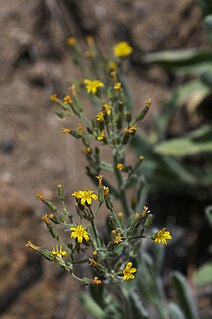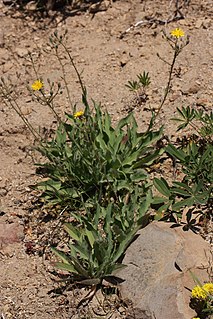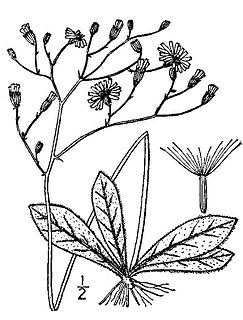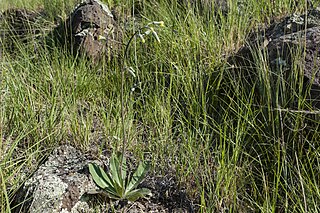
Hieracium , known by the common name hawkweed and classically as hierakion, is a genus of flowering plant in the family Asteraceae, and closely related to dandelion (Taraxacum), chicory (Cichorium), prickly lettuce (Lactuca) and sow thistle (Sonchus), which are part of the tribe Cichorieae. Hawkweeds, with their 10,000+ recorded species and subspecies, do their part to make Asteraceae the second largest family of flowering plants. Some botanists group all these species or subspecies into approximately 800 accepted species, while others prefer to accept several thousand species. Since most hawkweeds reproduce exclusively asexually by means of seeds that are genetically identical to their mother plant, clones or populations that consist of genetically identical plants are formed and some botanists prefer to accept these clones as good species whereas others try to group them into a few hundred more broadly defined species. What is here treated as the single genus Hieracium is now treated by most European experts as two different genera, Hieracium and Pilosella, with species such as Hieracium pilosella, Hieracium floribundum and Hieracium aurantiacum referred to the latter genus. Many members of the genus Pilosella reproduce both by stolons and by seeds, whereas true Hieracium species reproduce only by seeds. In Pilosella, many individual plants are capable of forming both normal sexual and asexual (apomictic) seeds, whereas individual plants of Hieracium only produce one kind of seeds. Another difference is that all species of Pilosella have leaves with smooth (entire) margins whereas most species of Hieracium have distinctly dentate to deeply cut or divided leaves.
A dry roadside dotted with small, ¾ inch red orange flowers, interspersed with very similar yellow ones, and often the white of daisies, is a good sign that you are in Hawkweed country.

Pilosella horrida, known as the prickly hawkweed or shaggy hawkweed, gets its name from the long, dense, shaggy white to brown hairs (trichomes) which cover all of the plant parts of this plant species. The species is native to Oregon, California, and Nevada in the western United States.

The Cichorieae are a tribe in the plant family Asteraceae that includes 93 genera, more than 1,600 sexually reproductive species and more than 7,000 apomictic species. They are found primarily in temperate regions of the Eastern Hemisphere. Cichorieae all have milky latex and flowerheads that only contain one type of floret. The genera Gundelia and Warionia only have disk florets, while all other genera only have ligulate florets. The genera that contain most species are Taraxacum with about 1,600 apomictic species, Hieracium with about 770 sexually reproducing and 5,200 apomictic species, and Pilosella with 110 sexually reproducing and 700 apomictic species. Well-known members include lettuce, chicory, dandelion, and salsify.

Pilosella scouleri is a North American species of flowering plant in the tribe Cichorieae within the family Asteraceae. It is known as Scouler's woollyweed. It is native to western North America, from British Columbia and Alberta in Canada, south to northern California and Utah in the United States.

Hieracium venosum is a species of hawkweed in the tribe Cichorieae within the family Asteraceae. It is widespread and common in south-central Canada (Ontario) and the eastern United States. Its common name comes from the fact that environments it is found in are typically also a home to rattlesnakes.

Hedypnois rhagadioloides, the Cretanweed or scaly hawkbit, is a species of plant in the tribe Cichorieae within the family Asteraceae. It is native to the Mediterranean Region and neighboring areas from Canary Islands to Iran, and naturalized in Australia and in parts of the Americas.

Hieracium alpinum, the alpine hawkweed, is a Eurasian plant species in the tribe Cichorieae within the family Asteraceae. It is native to Europe, and has also been found in Greenland.
Hieracium bolanderi or Bolander's hawkweed is a North American plant species in the tribe Cichorieae within the family Asteraceae. It is found primarily in the mountains of western Oregon and northern California in the United States, although there are reports of the species farther south in the San Bernardino Mountains in southern California and also in Baja California in Mexico.
Hieracium crepidispermum is a North American plant species in the tribe Cichorieae within the family Asteraceae. It is widespread across much of Mexico and found also in the US states of Arizona and New Mexico.

Hieracium fendleri is a North American plant species in the tribe Cichorieae within the family Asteraceae. It is widespread across much of the western part of the continent, from the Black Hills of Wyoming and South Dakota south as far as Guatemala.
Pilosella flagellaris is a European plant species in the tribe Cichorieae within the family Asteraceae. It is native to Europe but naturalized in scattered locations in the United States and Canada.

Hieracium gronovii or queendevil is a North American plant species in the tribe Cichorieae within the family Asteraceae. It is common and widespread across much of the continent from Ontario south as far as Florida, the Dominican Republic, and Panamá.
Hieracium longiberbe, known by the common name longbeard hawkweed, is a rare North American plant species in the tribe Cichorieae within the family Asteraceae It has been found only in the Columbia River Gorge along the border between the states of Washington and Oregon in the northwestern United States.

Hieracium longipilum, the hairy hawkweed, is a North American plant species in the tribe Cichorieae within the family Asteraceae. It is widespread across much of central Canada and the central United States from Ontario south to Texas and Louisiana. There are old reports of the species growing in Québec, but apparently does not grow there now.

Hieracium megacephalum, the coastal plain hawkweed, is a North American plant species in the tribe Cichorieae within the family Asteraceae. It grows only in the southeastern United States, in Georgia, Florida, and the Carolinas.
Hieracium parryi is a North American plant species in the tribe Cichorieae within the family Asteraceae. It grows only in the western United States, in southwestern Oregon and northeastern California. It is commonly known as woollyweed.
Hieracium pringlei, common name Pringle's hawkweed, is a North American plant species in the tribe Cichorieae within the family Asteraceae. It is native to Mexico with additional populations in Guatemala, Arizona, and New Mexico.

Hieracium scabrum, the rough hawkweed, is a North American plant species in the tribe Cichorieae within the family Asteraceae. It is native to eastern and central Canada and the eastern and central United States from Nova Scotia west to Ontario, Minnesota, and Kansas south as far as Georgia and Oklahoma.
Pilosella friesii – not to be confused with the European P. schultesii – is a North American plant species in the tribe Cichorieae within the family Asteraceae. It is widespread across much of Mexico with a few populations in Guatemala and western Texas.
Lactuca graminifolia, the grassleaf lettuce is a North American species of wild lettuce. It grows in Mexico, Central America, Hispaniola, and the southern United States from Arizona to Florida, Virginia and the Carolinas.











